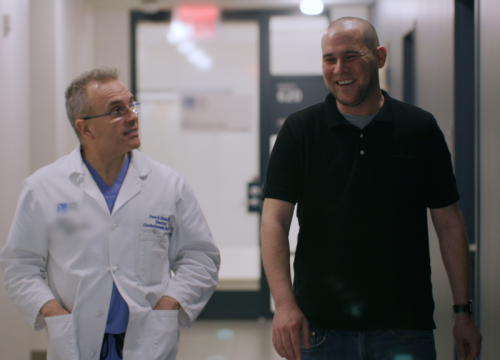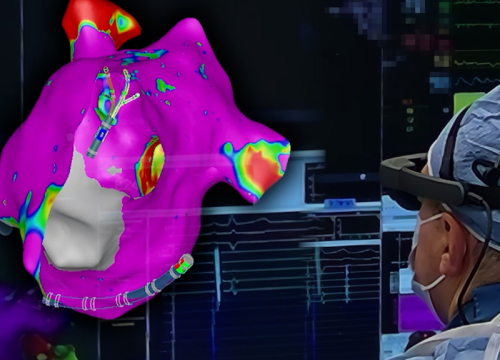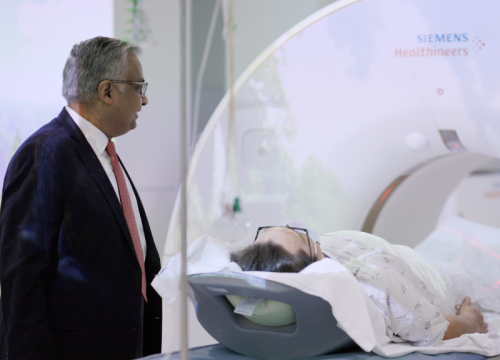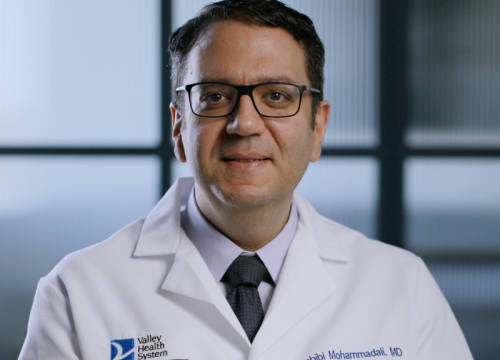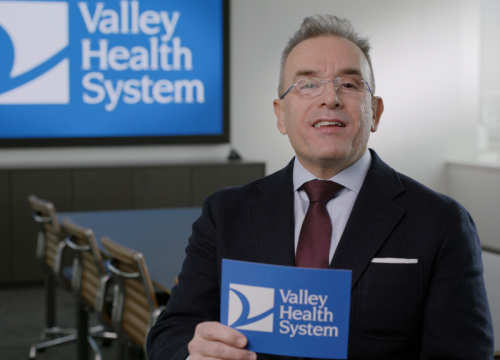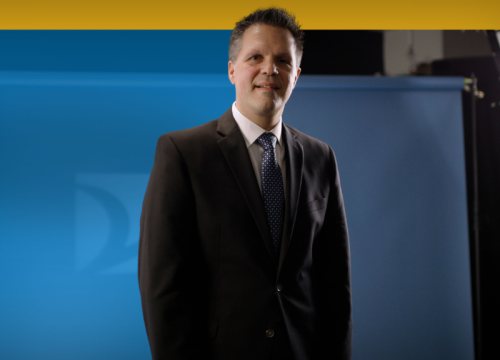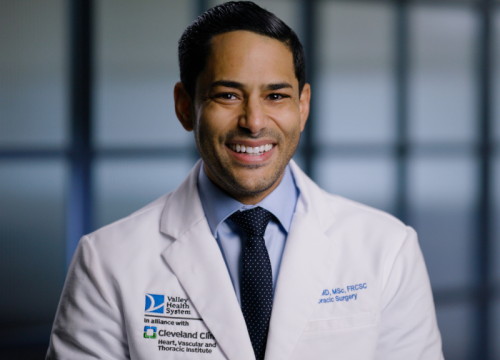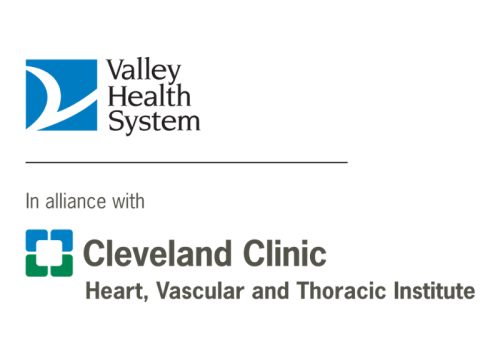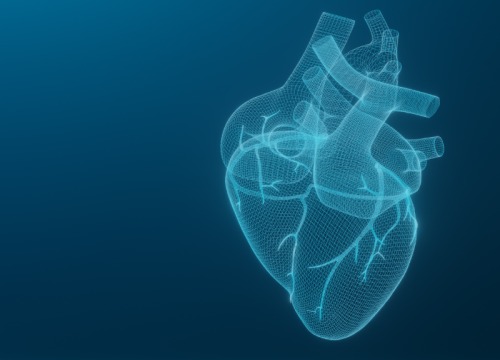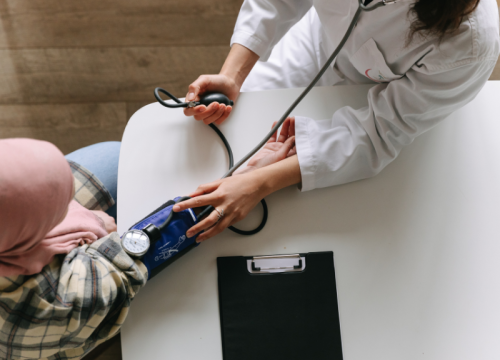Aortic valve surgery is an option for treating aortic stenosis (narrowing or blockage) and aortic regurgitation (leaky aortic valve).
Valley’s heart valve team is highly experienced in complex aortic valve repair procedures. Our heart surgeons, interventional cardiologists and advanced practice providers work closely to design the best care plan for you.
Whenever possible, we use minimally invasive aortic valve surgery and interventional approaches, which offer you a faster recovery. We also offer innovative procedures like valve-sparing aortic root replacement surgery, known as the David procedure.
Aortic Valve Repair and Replacement
The decision to repair or replace an aortic valve depends on your condition, age, overall health, goals and other factors. Your Valley provider will work closely with you to determine the best treatment option for your distinct needs.
- Valve repair: In general, the Valley team works to preserve your natural heart tissue and repair the valve whenever possible. Aortic heart valve repair may last longer than aortic heart valve replacement. Valve repair may also lower your risk for future aortic stenosis, offering improved quality of life.
- Valve replacement: There are two types of aortic valves used for valve replacement.
- Mechanical aortic valves are made from artificial materials. A mechanical aortic valve replacement lasts about 20 years before you need another replacement. And you’ll need lifelong blood thinner therapy.
- Biological aortic valves are made from human and animal tissue. Biological aortic valves last about 10-15 years before you need another replacement, but you do not need blood thinner therapy.
What to Expect: Aortic Valve Surgery
The aortic valve is one of four valves that controls blood flow through the heart. Valves have leaflets or flaps that keep blood flowing in the right direction, at the right time.
When your aortic valve is damaged, your heart works harder and less effectively.
Repairing the aortic valve may involve minimally invasive or open-heart surgery. Depending on your condition, your surgeon may:
- Insert a ring around the aortic valve to tighten it
- Restructure or reshape the aortic valve
- Patch holes or tears in the leaflets with tissue
- Support the aortic valve roots
- Separate leaflets that are stuck together
- Repair or replace the valve with a mechanical or biological valve
Open-Heart Aortic Valve Surgery
Open-heart surgery requires a 6- to 10-inch incision to open the breastbone. During the procedure, a heart-lung bypass machine will take over heart function and circulation.
The surgery can take approximately four hours. You’ll recover in the cardiac intensive care unit immediately after surgery. After 24 to 48 hours, you will move to a private hospital room to recover for another three to four days.
After open-heart surgery, your provider will discuss your recovery with you. Most people can return home after surgery. And you should be able to get back to regular daily activities within about four weeks.
Minimally Invasive and Interventional Aortic Valve Surgery
Minimally invasive surgery: Minimally invasive aortic valve repair involves a 2- to 4-inch incision between the ribs to access the heart. Just like open-heart aortic valve surgery, a heart-lung bypass machine will support your heart function. The procedure can take approximately four hours.
With minimally invasive surgery, you’ll typically spend less time in the hospital after surgery. And you’ll likely get back to regular daily activity in about 10 days.
Minimally invasive aortic valve repair is not an option for everyone. Your cardiac surgeon and you will discuss if it is right for you.
Interventional valve procedures: Minimally invasive interventional procedures do not require an incision in the chest.
- Balloon valvuloplasty: With balloon valvuloplasty, your provider inserts a thin tube (or catheter) with a balloon through a blood vessel in the wrist. The balloon is inflated to open a narrowed valve. You’ll likely go home the next day and resume regular daily activities within five to seven days.
- Transcatheter aortic valve replacement (TAVR): During TAVR, your providers will use a catheter, inserted into a small incision, to replace the aortic valve. You’ll typically go home within three to five days and resume regular daily activities within two to three weeks.
Rehabilitation After Aortic Valve Surgery
Rehabilitation can be a part of your recovery after aortic valve surgery. Valley offers cardiac rehabilitation that begins while you’re recovering in the hospital. And you can choose to continue the program after you leave the hospital.
Our cardiac rehab includes medically supervised exercises, nutrition guidance, stress management and more.
Why Choose Valley for Aortic Valve Surgery?
- Valve repair surgery expertise and experience: Our team has vast experience with aortic valve surgery and valve-sparing aortic root replacement surgery (the David procedure). Studies at Valley show that repaired aortic valves during the David procedure do not need replacement even 20 years later.
- Comprehensive aortic valve surgery options: If you’re not a candidate for aortic valve repair, we also offer the full range of aortic valve replacement surgeries. Our team has performed thousands of these surgeries, including transcatheter aortic valve replacement (TAVR) for severe aortic stenosis.
- Care for complex conditions: We specialize in advanced valve procedures, including the Ross procedure and the Ozaki procedure, for complex aortic valve conditions. We are also one of the few hospitals in the region to perform aortic root enlargements. This procedure can ultimately help make you a good candidate for TAVR.
- Complete, integrated services: Our advanced valve center provides comprehensive diagnostic imaging and care for all types of heart valve problems. Valley also offers integrated aortic care for patients with aortic aneurysms. We bring together a team of specialists to ensure you get coordinated care, all in one place.
- Shared decision-making and coordination: We approach every case as a team and make care decisions together — with you as a key partner. We’ll work with you to understand your options, the benefits and the risks. Our cardiovascular nurse practitioners help support and coordinate all aspects of your care. And our nurse navigators will help set up all your appointments, allowing you to focus on your health.
- Care and support after surgery: Our team will support you beyond aortic valve surgery. Before you leave the hospital, our team will walk you through the next steps. This includes everything from connecting you with cardiac rehabilitation to setting up home care arrangements if needed.


